China builds roads with speed unprecedented in human history.

Written by Nikolay Nikolaev; Originally appeared at A-specto, translated by Valentina Tzoneva exclusively for SouthFront
A few weeks ago, China opened on its territory a nearly 1,000-mile long highway in the northern parts of the country, in the autonomous region of Inner Mongolia. At first glance, there is nothing unusual as far as the 930-kilometre (km) stretch between Bayan Nur City and the village of Alha in North China goes … completely through the Gobi Desert. Many would ask what is the economic benefit of a road passing through the nothingness? On the territory of the Gobi Desert, which is 12 times larger than Bulgaria, live about as many people as in the municipality of Petrich (most of them in the country of Mongolia), and large reserves of natural resources are not available. The world’s longest highway through the desert, however, is part of the new Silk Road: ‘One Belt, One Road’. The completion of the highway of over 2,000 km will be finalised in June 2017 and the trip between the capital, Beijing, and Urumqi in Sindzyan – the Uighur autonomous region – will be shortened to 10 hours. From there, from the west, north and south stretch the vast spaces of Asia and Europe with the colossal economic prospects that they hide.
The Chinese leaders slowly but methodically move towards a grandiose infrastructure project of the new Silk Road. Beijing will not just build a fast transport and communication link with the countries of the Eurasian continent with this. The project, ‘One Belt, One Road’, aims to redefine global trade and financing and to transform the geopolitical architecture of the world, replacing the Atlantic and Pacific relations with Eurasian trade and economic and financial cooperation.
The economic belt of the Silk Road includes three trans-Eurasian economic passages: north (China-Central Asia-Russia-Europe), central (China-Central Asia-West Asia-Persian Gulf and the Mediterranean Sea) and southern (China-South-East Asia-South Asia-the Indian Ocean). The sea route foresees the establishment of two routes: one from China to the South Pacific region and the other to Europe. The ambitious idea is focused on building a large-scale transport infrastructure: highways, pipelines to transport energy, airports, ports, high-speed rail infrastructure and telecommunications networks to enhance trade, as well as economic, financial and cultural cooperation between the Eurasian countries. This project promises to end the centuries-long domination of the periphery’s naval forces to Eurasia over the supercontinent.
The release of the segment in the Gobi Desert will soon be followed by the implementation of several large-scale transport facilities. In the coming years, China will complete the construction of some colossal projects from where the basic infrastructure will start the Chinese expansion in the world.
The Bulgarian Prime Minister, Boyko Borisov, may be offended, but in recent years in the People’s Republic of Bulgaria (led by Todor Zhivkov), significantly more highways have been built than in China. This is for one simple reason: Beijing did not have one kilometre of highway until 1987. Under the leadership of four Ministers of Transport (Juan Dzhendon, Zhang Chunsien, Li Shanlin and Yang Chuantan), China built the largest highway network in the world. And now it’s only in the middle of its plans. Today, the Celestial has about 110,000 km in highways, surrounding the country from east to west and north to south; enough to tour the world nearly three times! Beijing planned to put into operation a total of 200 highways by 2030 (119 primary and 81 connecting) with the astronomical length of 260,000 km: the 12 rings of the planet Mars. Each year, Beijing builds motorway sections equal in length to the distance from the east to the west coast in the US and back. Stories about traffic congestion on Chinese highways lasting 11 days with 50 lanes in the region of Beijing sound stunning. But the truth is that the growing middle class in the country increases each year with a fleet of more than 20 million vehicles.
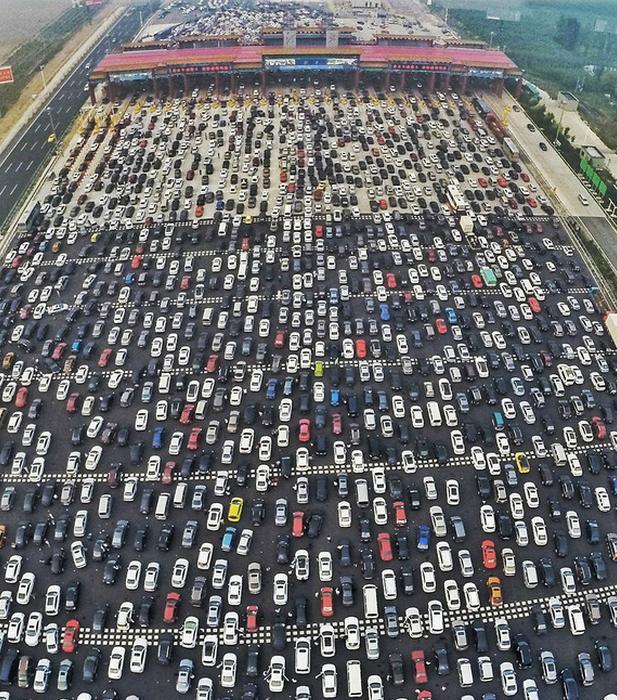 From September this year, the People’s Republic has a new transport minister: 57-year-old governor of the northern province of Shanxi, Li Syaopan. His appointment is symbolic. Syaopan is the son of former Chinese premier, Li Peng (1988-1998), and will be responsible for implementing the ambitious programme worth 4.7 trillion yuan (over US$720 billion) for the development of China’s transport infrastructure in the next three years. Improving the road system is without parallel in human history. Only within the next three decades, China will build infrastructure greater than the one created by the USA throughout its history.
From September this year, the People’s Republic has a new transport minister: 57-year-old governor of the northern province of Shanxi, Li Syaopan. His appointment is symbolic. Syaopan is the son of former Chinese premier, Li Peng (1988-1998), and will be responsible for implementing the ambitious programme worth 4.7 trillion yuan (over US$720 billion) for the development of China’s transport infrastructure in the next three years. Improving the road system is without parallel in human history. Only within the next three decades, China will build infrastructure greater than the one created by the USA throughout its history.
To solve the problem of overloading the automotive network, China is now planning another ambitious project: the construction of dense high-speed rail system allowing for movement of trains over 300 km/hour (km/h). The first high-speed lines in China are fairly recent. In 2007, the first line was put into operation and today, about 20,000 km of railway highways operate in the country; more than all other countries in the world combined! For the past year, the high-speed trains of the Celestial have shipped 1.1 billion passengers. The number of employees on the Chinese railways today is greater than the number of civilians working for the entire US government. The colossal network of speed lines is encircling the whole country with huge bridges, tunnels and viaducts, the largest of which is Viaduct Danyang-Kunshan, which has a length of 164.8 km (roughly the distance between Sofia and Skopje).
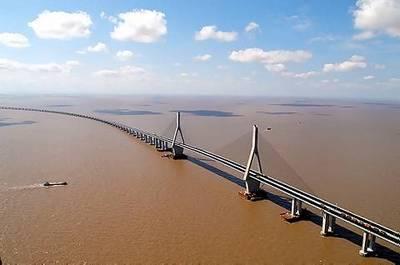 The dreams of the Chinese leaders do not stop there. Chinese Railways holds the record for the highest speed of a passenger train: 431 km/h. The largest manufacturer of equipment for rail transport in China recently announced that it has begun research and development for a new train type, “maglev,” which can develop speed of up to 600 km/h. The idea is for a similar facility to connect the mega-cities of Beijing and Shanghai, the distance between which is over 1,000 km. According to the plans of the Chinese authorities, by 2030, the country of Confucius should have brought into operation an unimaginable 45,000 km of high-speed railway lines.
The dreams of the Chinese leaders do not stop there. Chinese Railways holds the record for the highest speed of a passenger train: 431 km/h. The largest manufacturer of equipment for rail transport in China recently announced that it has begun research and development for a new train type, “maglev,” which can develop speed of up to 600 km/h. The idea is for a similar facility to connect the mega-cities of Beijing and Shanghai, the distance between which is over 1,000 km. According to the plans of the Chinese authorities, by 2030, the country of Confucius should have brought into operation an unimaginable 45,000 km of high-speed railway lines.
The Celestial has about 500 airports in the territory of the country. The number of air transport passengers has increased by over 50% over the past five years – amounting to more than 400 million passengers. The Chinese Communist Party aims to overtake the global leader in this indicator, the USA. By 2018, China will build the largest airport in the world: Beijing-Dasin, with a maximum capacity of 130 million passengers per year. The new mega-airport will cost US$13 billion, will have nine runways and will be built on more than 27,000 hectares (ha) of land. China’s plans and goals are to reach 2,000 air ports in the Celestial by 2030, meaning that the Chinese will build 100 airports annually.
China has more than 2,000 ports, allowing Chinese goods – currently amounting to nearly 40% of the freight transported by sea – to travel thousands of nautical miles to all corners of the world. At the beginning of the century, Beijing began the phased construction of a mega project: the deep-sea container port, Jansa, south of Shanghai. The special feature of the port is its location: on an artificial island into the ocean. Jansa Port is connected to land via the longest sea-bridge in the world (32.5 km) and last year, it handled nearly 37 million TEU (unit of measurement equivalent to 20 standard transport containers) and is on the way to becoming the biggest deep-water port ever built in the world. The port has a 20-km jetty and is not called by many “the eighth wonder of the world,” by chance.
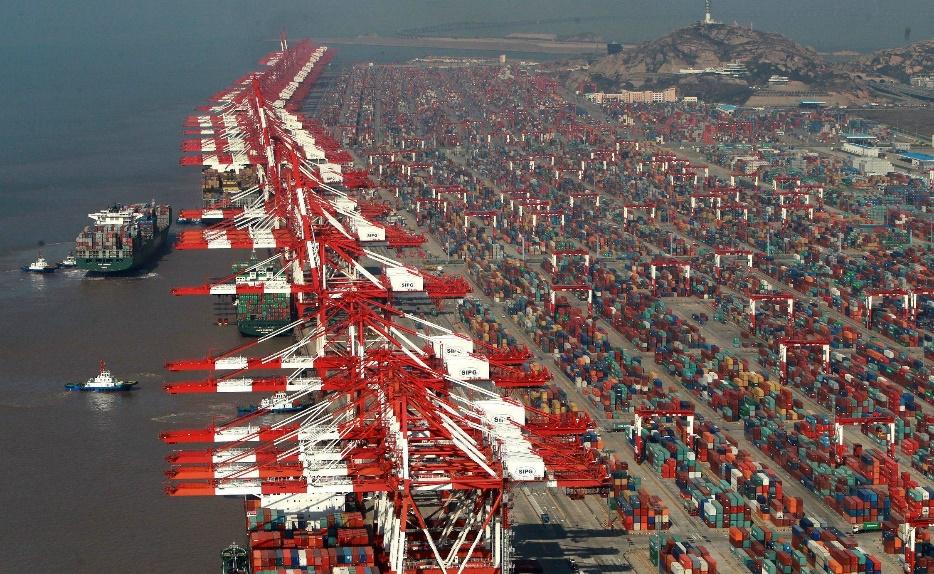
For ease the transport network, China plans to acquire the most colossal road facilities built in the history of mankind. Beneath the Bohai Sea, the longest undersea tunnel in the world should be completed by 2026. With its length of 123 km, it will surpass the two, so far longest, underwater tunnels together: the Japanese tunnel, Seiko, and the Channel Tunnel. The underwater tunnel will shorten the crossing distance between the two sides: it will take a little over an hour and a half instead of the current 12 hours. A high-speed railway track will be built as well.
Beijing is building the longest bridge in the world to ease the movements between Hong Kong, Zhuhai and Macao. The project is complicated from an engineering point of view and must find a solution to the huge traffic flow of ships at the estuary of Zhujiang and the unusually deep waters in the area. The 50-km facility will be the longest bridge; some 15 times greater than the ‘Golden Gate’ bridge in San Francisco. For its construction, more than 420,000 tons (t) of steel were used, the equivalent of 60 Eiffel Towers. North of Hong Kong, the Chinese government is building a second Megamall, which will build shortcuts in the agglomeration of over 40 million inhabitants.
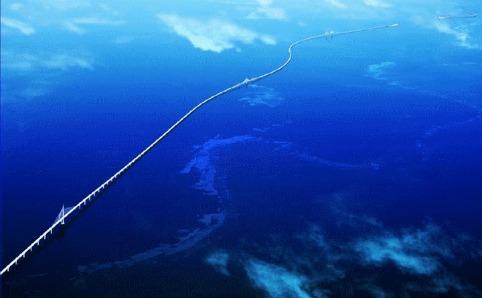 The super-infrastructure on Chinese territory resolves domestic issues, but is has another crucial purpose. The huge highways, ports, airports and high-speed lines serve as a base from which Beijing plans to connect its powerful economy with the countries of the Eurasian continent. The project, ‘One Belt, One Road’, is carried out in small but sure steps. Chinese state corporations, private investors and funds bought ports and airports across Eurasia in recent years. The most active strategy is the one in the Indian Ocean, emanating from the relative weakness of the Chinese armed forces against their American rivals.
The super-infrastructure on Chinese territory resolves domestic issues, but is has another crucial purpose. The huge highways, ports, airports and high-speed lines serve as a base from which Beijing plans to connect its powerful economy with the countries of the Eurasian continent. The project, ‘One Belt, One Road’, is carried out in small but sure steps. Chinese state corporations, private investors and funds bought ports and airports across Eurasia in recent years. The most active strategy is the one in the Indian Ocean, emanating from the relative weakness of the Chinese armed forces against their American rivals.
It is known that around two-thirds of the global trade in oil and half of the world’s maritime trade pass through the sea lanes of the Strait of Malacca. The mighty US Navy can, in acute conflict with Beijing, easily block the Straits and bring the Chinese economy to its knees. A few months ago, a 770-km pipeline was opened between Madai Island in Myanmar and China. The pipeline, which has a capacity of 22 billion t of oil per year, partly solves this dependence. The deep-sea port in Kyaokpyu, from where oil is transported to the Celestial, was won at an auction earlier this year by key Chinese company, CITIC Group, founded in 1979. The newly-established special economic zone, Kyaokpyu, in the Bay of Bengal, is a joint project between Chinese and Myanmar companies and it aims to significantly increase economic cooperation. More than 40% of all foreign investment in the former British colony of Burma comes from the People’s Republic. As you can guess, the investments are mainly in infrastructure.
Meanwhile, Myanmar’s neighbour, Bangladesh, is currently diverting the Chinese proposal for the concession of the largest deep-water port in the Bay of Bengal, located in the city of Chittagong. At an advanced stage is another Chinese investment for the port of Colombo in Sri Lanka. Under external pressure, the authorities of the small island nation were forced to freeze the project, but Sri Lanka’s huge debt and its inability to pay the Celestial back for the investments could make the country review its decision soon. Beijing also has an interest in the international airport in Matala and the deep-sea port in Hambantota. The largest Chinese step in the implementation of the project, ‘One Belt, One Road’, however, was made in Pakistan and the Persian Gulf. Beijing secured a 40-year lease of the Pakistani port of Gwadar and is currently expanding its capacity with an investment of nearly US$2 billion, which will make it a megaport. In the coming years, China will build the so-called Sino-Pakistani economic passage with an investment of US$51 billion. The bulk of the money is aimed at building roads, rail links and pipelines – a 1,152 km highway, Karachi–Lahore, a high-speed rail line, Karachi–Peshawar, a pipeline between the Iranian city of Navabshah and the port of Gwadar, and an oil pipeline between Gwadar and China. Despite the threats made by White House representative, Victoria Nuland, to Pakistan, the pipeline and some of the other projects are at an advanced stage of implementation.
The last major infrastructural direction of China in the Indian Ocean is East Africa. After acquiring a number of ports in Kenya, Djibouti and Eritrea, in the next three years China will implement infrastructure investments exceeding US$60 billion. The biggest transport investment ever made in Africa is a railway line from the port city of Mombasa in Kenya to Nairobi, Uganda, Rwanda and Burundi and the second section between Kenya and South Sudan. State company, the China Road and Bridge Corporation, will build the track, and the funding, worth US$14 billion will be provided by China’s Export-Import Bank.
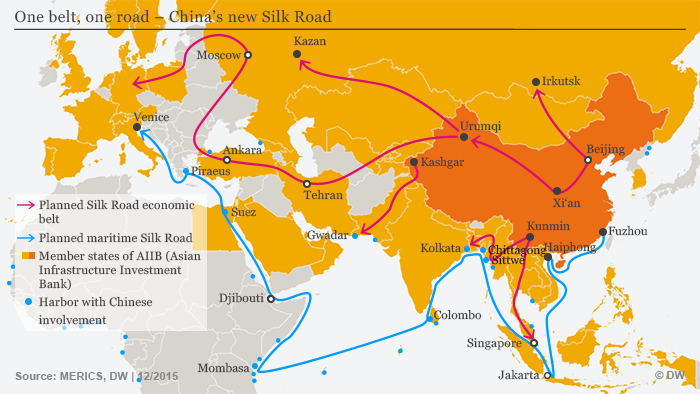
The northern Eurasian direction of the Chinese project, ‘One Belt, One Road’, is going at a good pace. Russia has a key role in its realisation. The two countries have already agreed the biggest energy projects for energy export from Moscow to Beijing in the history of the world. The project, ‘The Power of Siberia’, worth US$400 billion and the so-called West Route (‘The Power of Siberia-2’), will provide for the Chinese demand for natural gas. The pipelines are being built, and the first deliveries to the Celestial are expected in 2019.
The north conveyor path of the economic belt of the new Silk Road will pass through Russia. The two countries have already agreed to build a 770-km high-speed train route between Moscow and Kazan. For the construction of the section, Beijing plans to extend credit in the amount of 400 billion roubles for 20 years. With Russian permission obviously, the central direction of the economic belt will be realised. Recently, the first block train, loaded with Chinese goods, passed through Russian-populated parts of Kazakhstan to Tehran. This is the way to recover the ancient Silk Road, the Iranian railway company said, cited by France Press.
Bulgarian politics: when a man sits on two chairs, he falls on the ground.
This central direction should excite Bulgaria. The concept envisages the construction of a trans-Eurasian passage for economic interaction between China and Europe with an end-point: Rotterdam. The Greek government and the Chinese state corporation, COSCO, in April finalised a deal for the privatisation of the largest port in the country: Piraeus, Athens. The Chinese have already invested over €200 million in the two container-terminals near Athens, which they acquired in 2009, bringing the facility’s capacity to growth of over 2.5 million containers annually. In the next few years, an extensive modernisation, worth €350 million, will open the entrance of Chinese maritime transport in Europe. Transporting the goods from the port of Athens and the railway stations from the central axis of the Silk Road is of interest to Bulgaria. Chinese investors have already funded the underwater railway tunnel under the Bosphorus in Turkey, Marmaray, with US$2 billion. Europe and Asia were connected through a railway in the southern parts of the old continent in this way. The aim of a serious government should be fighting for the transport passage from Athens and Istanbul to pass through Bulgarian territory.
Regretfully, at present, it seems that Belgrade will be China’s major partner. Since the signing of the bilateral strategic partnership between China and Serbia in 2009, the Celestial has invested more than US$1 billion in the Serbian economy, mainly in infrastructure. A highway bridge over the Danube, connecting Zemun and Borce, was opened recently with Chinese financing. The building of a 350-km high-speed rail line between Hungary and Serbia started last year. The format 16+1, including China and the 16 countries of Eastern Europe, is a business forum in which leaders of countries like Poland and Romania also agreed to major Chinese investments in their countries.
Belgrade was selected to host the summit of 16+1 in 2014. The event was attended by Chinese Premier, Li Keqiang, and leaders of Eastern Europe. Whether under external pressure or not it is hard to say, but Borisov created another piece of his foreign-policy-stupidity as he was the only prime minister from Eastern Europe who did not respect the meeting. At the last moment, Rumyana Bachvarova was sent to the meeting, and the Serbian news agencies reported that seven Bulgarians who were involved in preparations for a protest against the violation of human rights in China, were arrested. A little later, the prime ministers of China, Serbia, Hungary and Macedonia signed an agreement to build a high-speed rail line passing by and not going through Bulgaria. The high-speed line from the Macedonian-Greek border to the port of Athens will soon be completed. As it became clear from the reception of Obama at the airport in Hangzhou this fall, the Chinese have a habit of saying, in a diplomatic manner, when a guest is not welcome. At the end of his visit to China last year for the meeting of the 16+1, Boyko Borisov was subjected to an unprecedented search by Chinese authorities at the airport in Beijing. Apparently, without thinking, our Prime Minister even suggested that the next meeting be held in Bulgaria.
As the Hungarian leader, Viktor Orban, recently said, we are witnessing “an east wind in the global economy.” Meanwhile, some nations make windmills while others lead imaginary hybrid wars, freeze cooperation and close joint economic projects. As we have already gotten used to, it is good to lay low when the strong winds come or simply to “listen to the superiors.” And while we do it, the Chinese train passes us by like a small Balkan station without stopping.




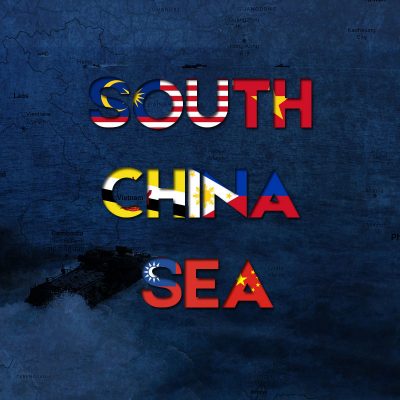
Time to Dust Off the old Little Red Book of the Chairman !! It was funny to me in my 17s – 18s but now it seems wonderful !! Study the Chairman my Friends !! https://uploads.disquscdn.com/images/d3381f3f304986ad0d27e7c97c62c374cece2033b36d1ab56a2536840a78fbf5.jpg
You are joking, right!?!
I never joke when discussing politics except if I have in front of me a known friend… As of now, Chinese and Russian actions may ultimatelly save the USA as a viable Republic, forcing the US Citizenry, to get rid of the Anglo Zionist cabal entrenched in its government, that is destroing it
But communism is a zionist construct. Mao, apart from being a genocidal butcher, was a communist. He killed 80 mil of his own, brother. Nothing to like there.
I see that your listening to Radio Free Europe or some other propaganda outfit !! 80 million butchered ?? LOL !! Communism a Zionist Construct = Obsolete III Reich propaganda…. Try something else !! Are you Ucranian ?? If you are a Banderista I wil understand If Mao was a Butcher, millions of Chinese will not revere him as a Saint. Don’t insult the readers of this forum inteligence !! Go back to your grave !! (PD : If Mao had killed just half of your figure, 40 million, China woul not have one baby per family rule, you fool !!
Whatever man… Looks like a complete waste of time to continue with this. I’ll go back to my grave where people actually understand history and use logic. Sleep long and well.
Love you China
China brings commerce and investment. The US not much.
Excellent article about the Great Game.